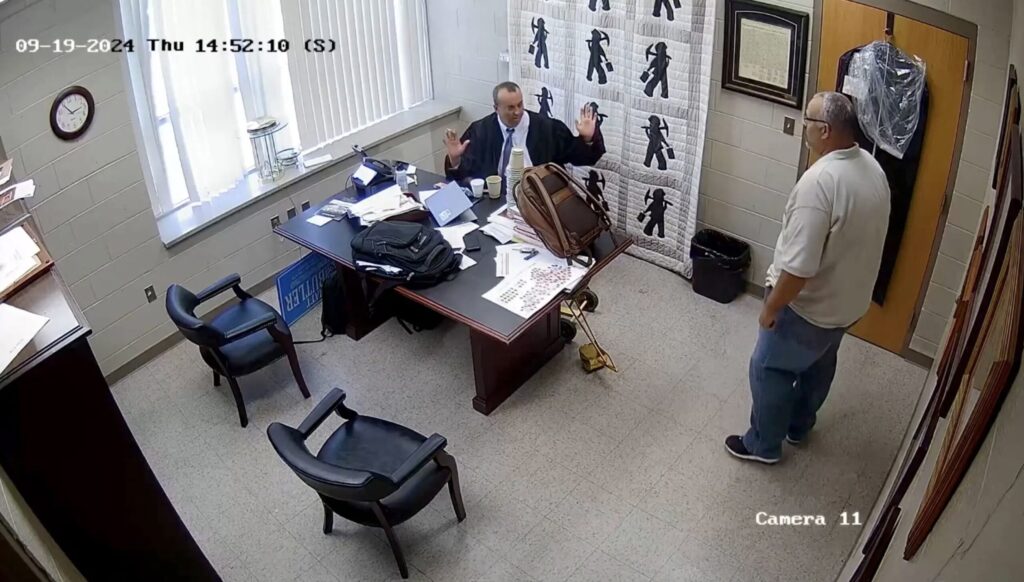In an unsettling turn of events, the tragic death of District Judge Kevin Mullins has drawn attention to allegations of rampant corruption and misconduct within the courthouse. Gunned down by former Sheriff Shawn “Mickey” Stines, Mullins is now at the center of disturbing claims suggesting that his chambers operated like a “brothel.” These allegations emerge amidst police recordings uncovered by NewsNation, which hint at a malicious web of sexual exploitation and abuse of power. The investigation into former Deputy Ben Fields, who was already convicted of serious crimes including rape and perjury, indicates that the courthouse may have been a place where justice was obscured by impropriety and manipulation.
Sabrina Adkins, one of Fields’ victims, has shared harrowing accounts with investigators regarding the alleged complicity of Mullins and other figures in the courthouse in extorting sexual favors from women, primarily inmates, in exchange for leniency in legal matters, such as reduced sentences or waiving fees. Adkins has claimed to have witnessed explicit videos filmed within Mullins’ chambers, allegedly depicting sexual acts involving the judge and female inmates. This shocking testimony raises serious questions about the integrity of the justice system in this Kentucky courthouse and paints a picture of a corrupt institution where exploitation may have been routine.
According to investigators, Adkins provided further detail, affirming she had seen a video capturing Mullins engaging in sexual activities with female inmates in his office. When asked about the specifics, she referred to Judge Mullins by name, confirming it was indeed his chambers they were in, and illustrated a troubling culture where power dynamics were manipulated for sexual gain. Such testimonies suggest that the courthouse was not merely a site of judicial proceedings but a location where the vulnerable faced exploitation at the hands of those they were supposed to rely on for justice.
In the backdrop of these revelations lies the tragic story of Mullins’ murder. While Sheriff Stines awaits trial, he has denied any knowledge of Mullins’ alleged misconduct. Interestingly, sources suggest that Mullins might have been preparing to testify against Stines in a civil case related to allegations made by Adkins. Stines’ resignation from his position as sheriff the day before Mullins’ death raises eyebrows, as does the fact that he was present at a deposition pertaining to the case against him shortly before the incident. This connection has led some to speculate that Stines might have had a motive for the shooting, potentially to silence Mullins.
The defense strategy put forth by Stines’s attorney argued that the shooting stemmed from “extreme emotional disturbance” rather than premeditated murder, claiming that Stines was not in a rational state of mind at the time. During the ongoing court proceedings, chilling surveillance footage captured the moments leading up to Mullins’ death, revealing Stines firing multiple rounds at the judge, who desperately attempted to shield himself behind his desk. This dramatic scene, coupled with Stines’ question regarding a private meeting prior to the shooting, illustrates the confusion and tension underpinning their relationship.
Despite sharing a seemingly normal lunch together prior to the incident, an unsettling comment made by Mullins about needing a private meeting casts a shadow over their interaction. State Police Detective Clayton Stamper provided testimony, shedding light on the grim interactions, including Stines’s unusual request to use Mullins’ phone to contact his daughter. The details surrounding Stines’ sudden transition from a seemingly benign conversation to violence remain murky, with the investigation ongoing. The troubling context surrounding Mullins’ murder, intertwined with allegations of corruption within the courthouse, signals a profound crisis of trust in the justice system that is desperate for accountability and reform.

